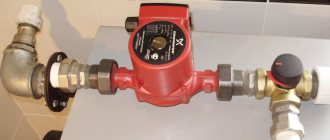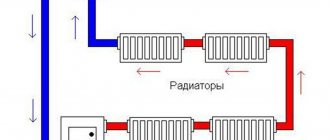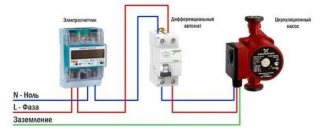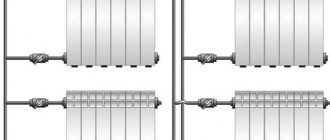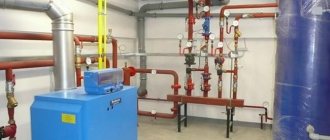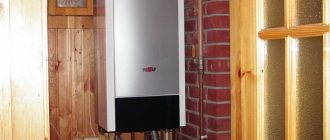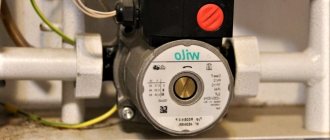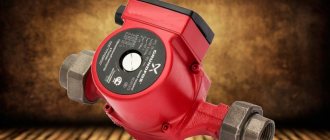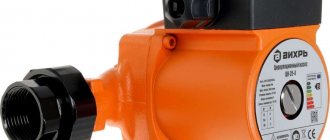Ever since someone came up with the idea of integrating a circulation pump into the heating main, these units have been used to increase the efficiency of heating rooms more and more often. They can be found in heating stations of high-rise buildings, in private houses, in systems powered by boiler houses.
The connected device significantly increases the speed of movement of the working medium, increasing the heat transfer of radiators. But the device does not always work flawlessly. Sometimes malfunctions occur, and consumers cannot understand why the pump in the heating system is noisy. To find out, you need to determine the reason why the device is behaving incorrectly, and then fix it.
How circulation pumps are designed and work
The operating principle of circulation pumps is not much different from the design of drainage models. The device body is made of durable materials that are resistant to corrosion. Typically this is stainless steel, aluminum, brass, cast iron. When started, the engine begins to rotate a rotor equipped with an impeller. As a result, the pressure at the inlet pipe decreases and water is sucked into the hydraulic chamber. The rotation of the impeller creates centrifugal force. Water is pressed against the walls of the chamber and forcefully thrown into the pipeline through the outlet. This ensures forced circulation of the coolant in a closed heating circuit.
Design differences between different types of devices
There are two main types of pumps - with “wet” and “dry” rotors. The “wet” rotor is separated from the water by special sealing rings, between which there is a thin film of water. When worn, the rings wear out and are pressed closer to each other, which guarantees the tightness of the structure for several years. Cooling and lubrication are provided by the working fluid. Pumping equipment of this type is installed in systems with small coolant volumes, because It is difficult to ensure tight connections in large-diameter structures
When installing devices, it is important to ensure that the shaft is positioned strictly horizontally, otherwise the device may malfunction
The main advantage of “dry” models is their high efficiency. It is 80%, which distinguishes it favorably from the 50% efficiency of “wet” type devices. The rotors of “dry” heating circulation pumps do not come into contact with the liquid. Depending on the location of the engine, structures are divided into horizontal (cantilever), vertical and block. All “dry” models are noisy during operation and are sensitive to the quality of the coolant and air purity. It is advisable to install them in separate rooms of boiler rooms, controlling the purity of the water in the system and the air in the room.
source
Operating rules
To prevent breakdowns, follow the operating rules:
- It is prohibited to operate the house heating pump if there is no water in the system;
- do not use the unit at zero supply;
- During operation, feed limits are observed;
- to prevent oxidation during downtime, the unit must be turned on for fifteen minutes;
- the temperature of the working fluid does not exceed sixty-five degrees Celsius;
- no leaks at pipe connections;
- no heating of the unit;
- Do-it-yourself pump installation involves horizontal placement of the shaft.
If the rules are followed, the unit can last ten years.
Why does the heating pump get hot?
When installing a closed-type heating system, a circulation pump is installed on the pipeline. The main task of this device is considered to be pumping coolant, water or antifreeze, which ensures quick and uniform heating of all living areas of a dacha, cottage or any other country house. Thanks to the pump and boiler automation, the user can set the optimal temperature in his home, but sometimes such a device overheats and cannot perform its assigned tasks efficiently. In our article we will get acquainted with the reasons for this phenomenon and methods for solving such a problem.
Diagnostics
Units of this type are conventionally divided into two groups: “wet” and “dry”. The latter are equipped with a fan, which is noisy even in normal mode, as manufacturers and sellers warn about. If backlashes appear during operation, the noise increases. Such a device must be installed in a separate room with good sound insulation. But sometimes experts install it in the living room or kitchen, arguing that it is highly efficient.
If the “wet” unit is noisy, you will need to diagnose the entire heating system. During this work, it may turn out that the water device is not to blame - the creaking is heard for another reason. It will need to be eliminated. If you follow the rules for installing, starting and operating the heating system, there will be fewer problems.
We recommend reading: Muffler for ventilation: types and manufacturers, installation instructions and installation rules
Possible breakdowns and ways to eliminate them
troubleshoot the problem as necessary. By the way, it is recommended to protect the pump from surges in the network by installing a reliable stabilizer. This move will also protect the pump from the burning of a fuse, which fails as a result of constant pressure drops in the network
So, if something goes wrong with your circulation pump and it refuses to work, then we’ll try to repair the unit ourselves.
Important: but if you are not confident in your abilities or do not have the appropriate tool at hand, then it is better to contact a specialized center
If the pump makes a hum, but the impeller does not rotate
The reasons may be the following:
- Presence of a foreign object in the impeller area;
- The rotor shaft has oxidized due to long-term downtime of the unit;
- Loss of power supply to the mechanism terminals.
In the first case, you need to carefully remove the pump from the heating system and unscrew the housing in the area of the impeller. If a foreign object is found, remove it and rotate the shaft by hand. When assembling the pump in the reverse order, it is necessary to install a reliable filter on the pipe.
If there is oxidation, then clean it well, lubricate all movable elements of the working unit and reassemble the pump in the reverse order.
If there is a problem with the quality of the power supply, then you will have to check the voltage using a tester. First, completely replace the cable in all sections of the cable and if a break or fault is detected. Then, if the cable is OK, check the voltage at the terminals. If the tester shows infinity, a short circuit has occurred. If it shows less voltage, it means that the winding has broken. In both cases, the terminals are replaced.
If the unit shows no signs of life at all
This can happen if there is no voltage in the network. Using a tester, check the voltage and, if necessary, correct the problem.
By the way, it is recommended to protect the pump from surges in the network by installing a reliable stabilizer. This move will also protect the pump from the combustion of a fuse, which fails as a result of constant pressure drops in the network.
If the pump starts but then stops
The reasons may be:
- Presence of scale between the moving elements of the unit;
- Incorrect pump connection at the terminals.
In the first case, you will have to disassemble the pump and check it for scale. If detected, limescale deposits are removed and all joints between the rotor and stator are lubricated.
If there is no scale, then check the tightness of the fuse on the unit. You should remove it and thoroughly clean all the clamps. Here it is also worth checking that all wires in the terminal box are connected correctly in phases.
If the pump makes a loud noise when turned on
The reason for this is the presence of air in a closed circuit. It is necessary to release all air masses from the pipes, and install a special unit in the upper part of the pipeline to prevent the formation of air locks.
Another reason could be wear on the impeller bearing. In this case, you need to disassemble the unit housing, check the bearing and, if necessary, replace it.
If the pump is noisy and vibrates
Most likely, the issue is insufficient pressure in the system. It is necessary to add water to the pipes or increase the pressure in the area of the pump inlet.
If the pressure is still low
Here it is worth checking the direction of rotation of the working unit in the pump body. If the wheel does not spin correctly, then an error was probably made when connecting the device to the terminals in phases when using a three-phase network.
Another reason for a decrease in pressure may be too high a viscosity of the coolant. Here the impeller experiences a lot of resistance and does not cope with the assigned tasks. You will have to check the condition of the mesh filter and clean it if necessary. It would also be useful to check the cross-section of the inlet and outlet pipes and, if necessary, set the correct operating parameters of the pump.
Repair Basics
The modular principle is the principle on which the structure of the wet rotor pump is based. At the same time, the modules can be configured in a variety of ways - directly depending on parameters such as the power and size of the device itself.
If you take on the repair yourself, be sure to remember a vital rule: you can carry out various types of work with the circulation pump and other elements of the heating system only if the area has been drained and its power has been completely turned off
Blocking
A common malfunction is characteristic sounds, despite the fact that the shaft inside it does not move. Experts attribute the main reason to the phenomenon of shaft oxidation, which occurs as a result of the device being inoperative for a long time. If the pump is blocked, the device must not be left turned on. In this case, drain the water and unscrew the screws holding the pump housing and the electric motor.
Next, you will need to remove the motor and turn the impeller by hand. If the power of the equipment is low in terms of production characteristics, unlocking the shaft is possible with a simple screwdriver.
Disassembled circulation pump
There are no sounds like the hum of a heating circulation pump, the device does not turn on and there is no supply voltage. The fuse may be damaged here, and if this is indeed the cause of the malfunction, then this element of the device should be replaced. If such an action does not bring any changes, then you should check whether the motor winding has burned out.
If the wheel is blocked by any foreign part, you need to dismantle the pump motor as described above. It is also recommended to install a mesh-type filter to prevent recurrence of this malfunction.
Vibration
As a rule, this is a consequence of bearing wear, which, in turn, is additionally characterized by recognizable sounds. To eliminate such a malfunction, it is obviously necessary to replace the bearing.
Bearing replacement
Power problems
Difficulties with power supply. Checking the voltage and the prescribed indicators in the technical data sheet of the device is the first thing you should do. In addition, it is necessary to check the condition of all phases and the reliability of the connection of all elements of the terminal box.
Activation of the external motor protection shortly after the unit starts operating. It is likely that you will have to look for faults in the engine itself, in its electrical component.
Self-shutdown
A common cause of this problem is deposits formed between the rotor and the stator jacket. The repair consists of detailed disassembly of the engine and cleaning of the stator.
The loud noise when starting the device can be completely eliminated by releasing excess air and installing an automatic air vent.
Release of excess air from the circulation pump
If the water supply and pressure do not correspond to the specified parameters in the technical data sheet of the device (most often, the real indicators are significantly lower than those specified in the document), then you should check whether the pump itself was connected correctly. This especially applies to three-phase devices.
Unit features
The principle of operation of circulation pumping equipment is based on creating continuous circulation of liquid in the system without changing the pressure indicator
A circulation pump is a device that operates in a closed heating system and moves water in a pipeline. The unit maintains a certain temperature of the coolant in the system. The device does not replenish coolant losses and does not refill the system. The system is filled using a special pump or a certain pressure in the pipes.
The principle of operation of circulation pumping equipment is based on creating continuous circulation of liquid in the system without changing the pressure indicator. Since after installation the device operates constantly, the main requirements for such pumps are low noise level during operation, economical energy consumption, reliability, durability and ease of use.
Important: circulation pumps are compact devices that do not take up much space and do not create noise during operation. The scope of use of circulation units for heating systems is quite extensive.
They are installed:
The scope of use of circulation units for heating systems is quite extensive. They are installed:
- in traditional radiator systems;
- when installing a water heated floor;
- in geothermal systems;
- when organizing hot water supply for cottages and dachas.
Unlike forced circulation systems, this pumping equipment does not require pipes with an increased diameter. In addition, the device has the following advantages:
- speed of heating the room;
- the boiler can be installed in any suitable place;
- coolant losses and air pockets are minimized;
- The thermal relay ensures automatic control of temperature conditions;
- Electricity costs are reduced due to the use of automatic rotor speed control;
- Since liquid is constantly supplied to heating devices, their service life is extended.
Elevator unit
Those households whose apartment is located on one of the lower floors, and above which there is an elevator unit, have to constantly “enjoy” the noise from the heating radiators. This is due to the fact that the normal operation of the elevator unit is always accompanied by a hum.
The elevator unit has a mixing chamber, where the process of mixing hot water from the supply and cool water from the return is carried out. In this chamber there is a section called the “nozzle”, it is here that a jet of water with high pressure is injected into a mixing chamber filled with liquid with lower pressure. It is clear that the pressure difference between the nozzle and the chamber of 2-4 atm leads to noise being produced.
Reasons why the circulation pump is noisy
The main condition for long-term and trouble-free operation of the device is proper installation, carried out in strict compliance with the manufacturer’s recommendations.
If the circulation pump is humming, you should make sure that all installation operations were carried out without violations. To prevent this problem from occurring, experts recommend installing a pressure membrane tank (hydraulic compensator). With its help you can control the static pressure in the system. A membrane tank will eliminate cavitation loads, which not only contribute to the creation of hum, but also negatively affect the service life of the device.
In order to create comfortable conditions for living in the house, you should choose the right location for installing the pump. It should be determined by the design features of the equipment
Particular attention should be paid to purifying the water used in the system. Many people are wondering why the circulation pump is humming at the beginning of the heating season? As a rule, this happens due to the fact that when the communications are filled with system liquid, air enters the heat-conducting pipes and the body of the pumping device
Air pockets can be removed through special holes equipped with screw plugs
Many people are wondering why the circulation pump is humming at the beginning of the heating season? As a rule, this happens due to the fact that when the communications are filled with system liquid, air enters the heat-conducting pipes and the body of the pumping device. Air pockets can be removed through special holes equipped with screw plugs
Valves for removing air from the system should be located at the highest points of the heating system elements. Before each start of the system, make sure that there is no air in the system. Modern models of circulation pumps, due to their design features, do not require maintenance. Dirt accumulated during the summer period of inactivity can be removed by turning on the booster motor at maximum power.
Circulation pumps with automatic adjustment during operation do not create noise in the thermostatic pipeline valves. They quickly respond to the slightest changes in the heating system. For example, when a thermostatic valve opens or closes, the device automatically changes its technical characteristics without consuming excess electricity. Electronically controlled devices do not require manual deflation.
The circulation pump can also hum as a result of mechanical failure. It can be eliminated only after installing and disassembling the device. As a result of long-term operation of equipment, technological gaps increase. The problem can be solved by replacing the adjusting washers. This measure will prevent axial runout of the motor shaft.
Also, the cause of loud operation of the pump can be wear of the working surfaces and shaft bushings. In this case, it will be necessary to replace parts that have become faulty, while simultaneously grooving the shaft. This will help prevent radial runout of the units.
The causes of cyclic noise in the circulation pump are burning of the motor windings or interturn breaks. Such breakdowns can be repaired by specialists who repair electric motors and have professional skills and the right set of tools.
Where did the noise come from?
Before removing the pump and sending it to a service center, you should find out the cause of the noise.
Indeed, in some cases it can be eliminated independently, without resorting to the services of specialists. If the pump hums more than it makes noise, read this material.
First, you need to determine exactly: is the pump itself noisy, or is the hum going throughout the entire system? If extraneous sounds come from pipes and radiators, this means that air has entered the system. In this case, the solution is quite simple - you need to bleed it off. Quite often, this situation is observed in systems that have just been launched - that is, during commissioning or after a long period of inactivity (at the beginning of the heating season).
Read how to bleed air in a heating system.
Important: if a heating system that is just being put into operation is noisy (the noise is coming through the pipes and radiators) and bleeding the air does not help, you should carefully inspect the pipes. Perhaps an error was made during installation and the pipe is in contact with the wall
This may also cause strange sounds.
If the heating pump is noisy, there may be several reasons for this:
- Air. In this case, it needs to be vented by unscrewing a special plug on the body of the device itself.
- Incorrect rotor position. Often observed in systems that are just being put into operation. The noise may indicate that the rotor is positioned vertically, which is unacceptable. The solution to the problem in this case is to dismantle and properly install the device.
- In some cases, the cause of extraneous noise may be wear of individual elements (bearings). In this case, the parts should be replaced.
- Manufacturing defects. Unfortunately, sometimes such a cause of noise occurs. And if possible, the device should be replaced under warranty. If this is not possible, the most rational solution would be to replace the device itself.
Equipment Features
In some cases, the noise of the circulation pump is normal. This applies in particular to pumps with a dry rotor. The fact is that while actively moving, the rotor is a source of noise and vibration. Moreover, if the power of the device is high enough, the noise will be very strong.
And in this case, there are only two possible solutions to the problem:
- soundproofing the room;
- replacement of circulation equipment.
Manufacturers of dry rotor pumps honestly warn about this “side effect”. Therefore, when you open the instructions for the device, you can find a similar recommendation to “install in a separate room with a high level of sound insulation.” And if you have not noticed this point before, and the pump was installed in one of the common rooms, then there are two options for solving the problem. First of all, try to partially soundproof the pump. Today on the market you can find special casings that fit directly onto the device. Such a “fur coat” will not eliminate noise completely, but it can significantly reduce its level.
The second option is to move the pump to a separate room, while observing all installation recommendations.
Important: in order to ensure that the malfunction that causes the pump to make noise is not detected at the height of the heating season (when manipulations with the pump are undesirable, since it is constantly needed for heating), it is recommended to occasionally start the device during the non-heating season. Sources
- https://teplospec.com/montazh-remont/pochemu-shumit-tsirkulyatsionnyy-nasos-otopleniya-i-kak-eto-ispravit.html
- https://ogon.guru/otoplenie/komponenti-sistemi/nasos/pochemu-shumit.html
- https://otoplenie-doma.org/remont-cirkulyacionnogo-nasosa-dlya-otopleniya.html
- https://opt-stroy.net/pochemu-gudit-cirkulyacionnyjj-nasos-otopleniya.html
- https://www.PortalTepla.ru/nasosi/pochemu-shumit-cirkulyacionnij-nasos-sistemi-otopleniya/
- https://kvarremontnik.ru/pochemu-gudit-cirkulyacionnyjj-nasos-otopleniya/
- https://kvarremontnik.ru/shumit-nasos-otopleniya/
Actions for prevention
In operating condition, monitor the engine heating level. If it seems too high to you, then it is better to remove the pump and contact the point of sale with a request to replace the unit. The same can be done in case of pressure mismatch
Also, to protect pumping equipment from sudden failure, it is recommended to carry out preventive maintenance of the unit, which will include the following actions:
- Regular external inspection of the pump housing and careful listening during operation. This way you can check the functionality of the pump and the tightness of the housing.
- Make sure that all external pump fasteners are properly lubricated. This will make it easier to disassemble the pump if repairs are necessary.
- It is also worth following some rules when installing a pumping unit for the first time. This will help avoid repair work in the future:
- So, when you first connect the pump to the heating network, you should turn on the unit only if there is water in the system. Moreover, its actual volume must correspond to that indicated in the technical passport.
- It is also worth checking the coolant pressure in the closed circuit here. It must also correspond to what is stated in the technical specifications of the unit.
- In operating condition, monitor the engine heating level. If it seems too high to you, then it is better to remove the pump and contact the point of sale with a request to replace the unit. The same can be done in case of pressure mismatch.
- Also, make sure that there is a ground connection between the pump and the terminals when connecting the pump. Here in the terminal box, check that there is no moisture and that all wiring is securely fixed.
- A working pump should not produce even minimal leaks. The connection points between the inlet and outlet pipes of the heating system and the pump housing deserve special attention.
Danger of water hammer
During a water hammer, the pressure at the point where the flow is abruptly interrupted can reach several tens of atmospheres. Theoretically, it can generally be infinite, but in a practical situation, the water still contracts a little, the pipes stretch a little (even though they are metal). In addition to the unpleasant knocking sound, water hammer can cause more serious problems. Inelastic pipes, threaded connections, valve parts, stretching (albeit very slightly) under the influence of water inertia, can quickly collapse.
The force of the water hammer depends on the length of the pipeline in which the current is blocked. The strongest water hammer is in underfloor heating systems, since there is a very long pipeline. Water hammer is dangerous if the thermostat is installed at the outlet of the heating circuit. If a thermostatic valve is installed at the inlet, water flows out of it into a long pipeline. Inertia causes water to move away from the valve for some time, even when it has already closed. A vacuum arises. The maximum pressure drop in this case can be no more than one atmosphere, which is quite a bit, especially if you remember that according to standards, the heating system must withstand short-term surges of up to 4 atmospheres. If you shut off the water at the outlet of the circuit, the pressure can reach tens of atmospheres.
Best answers
Marat Musin:
LOOK AT THE PASSPORT WHAT LIQUID SHOULD BE FILLED
******:
It looks like it runs dry or there is no water flow through it.
Vladimir Petrov:
Check the system; it looks like your water is simply flowing poorly into the new branch or not at all. And you cleaned the filter, maybe that's the problem. Or on a new branch of a pipe of small diameter. And also check that you have installed it correctly, there is an arrow in the direction of the water
Viktorij Lashhehova:
❝Actually, what could be the problem? ❞If there were financial disagreements when paying with the contractor, then you need to resolve them and then everything will work correctly for you.
Stubborn Like Dac:
It appears that the pump rotor is not turning. At the end of the pump there is a plug with a slot for a screwdriver. Unscrew this plug and tap on the rotor axis with a metal object (for example, the same screwdriver) ... I had a similar situation last year and after several light blows with a screwdriver, the pump started working and is still working.
The device is so hot that a boiler is not needed. Why does the pump in the home heating system get hot?
Improper operation of the circulation pump leads to various problems, including overheating.
Due to overheating, pumping equipment may fail, which will lead to the stoppage of the entire heating system. This is especially dangerous in winter.
ontakte
Odnoklassniki
The purpose of installing such a device is to pump fluids in the heating system and create pressure. These processes help heat the heating device, but not critically.
The temperature of the circulation unit and pipes should be approximately the same. If the deviation is large, then this is already overheating of the device.
What to do if pumping equipment gets hot
If a problem occurs, pay attention to the openness of the shutoff valve system. Then you need to check whether the pump was installed correctly
The choice of installation location also matters.
Next, you need to check the return valve and rotation mechanism. Additionally, carry out preventive maintenance of the system and release excess gas from the pipes. You can compare the heating of the pump and the return valve. If it differs too much, you need to contact a specialist.
The pump for forced supply of liquid to the heating system becomes very hot during operation. This is a common problem in private homes and is associated with many factors. To prevent damage to equipment, it is advisable to carry out preventive maintenance and repairs in a timely manner. In this case, the heating of the room will not be interrupted at the wrong time.
average rating
more than 0 ratings
Share link
Should the circulation pump heat up on heating?
The main function of a circulation pump in a heating system is to pump hot liquid through the pipelines of heating and hot water supply systems. Forced circulation of the coolant is necessary to ensure rapid and uniform heating of all rooms of the building.
Pumps are installed in buildings of any type and purpose, if provided for by the heat supply project. Thanks to them, you can create a comfortable microclimate in your home, regardless of the weather and climatic conditions of the area. However, no technique is perfect. Sometimes the heating circulation pump gets hot and does not perform its functions well.
What is the problem? Is it possible to understand the reasons for the device overheating and eliminate them yourself?
Grundfos brand pump. Devices of this brand are in demand among our compatriots
Why does the circulation pump heat up - the main reasons
Ideally, the pump temperature should be the same as the coolant pipes. If it is higher, it means that either errors were made in the installation, or there are problems with operation. Typically, the circulation pump of the heating system gets hot for the following reasons:
- Incorrect installation. The easiest way to determine the presence of installation errors is: the device begins to overheat at the initial stage of operation of the heating system.
- Clogged system. Over time, various deposits and rust accumulate in the pipes. This leads to a narrowing of the water passage diameter. The pump has to work at increased load to push the coolant into the narrowed pipes, and the electric motor overheats. Preventive measures will help “cure” it - unscheduled maintenance of the heating system.
- Foreign body. If communications are slagged, pieces of rust or limescale may come off the internal surfaces of pipes and radiators. When they get into the pump, they jam the electric motor. The result is usually predictable: if you do not disassemble and clean the device in time, the motor coils will fail.
- Lack of bearing lubrication. If it is not enough, the bearings wear out much faster, which shortens the service life of the entire device as a whole. The engine jams. It is advisable to dismantle the pump and take it to a workshop.
- Low voltage in the network. If the voltage is below standard 220 V, the engine overheats and quickly fails. At the first signs of overheating, it makes sense to determine the voltage in the network using a voltmeter. Perhaps the problem is not in the pump itself.
Do-it-yourself preventative cleaning of batteries
: professional heating system flushing
If the circulation pump gets hot, the reasons can be very different. Do not rush to dismantle the device. First, measure the voltage in the network. If it is normal, flush the system with caustic soda, filling it for at least an hour, and then draining the solution. If this does not help, contact a specialist, otherwise the device will burn out and you will have to buy a new one, because rewinding the motor windings can be more expensive.
votes, average:
4.96 5)

